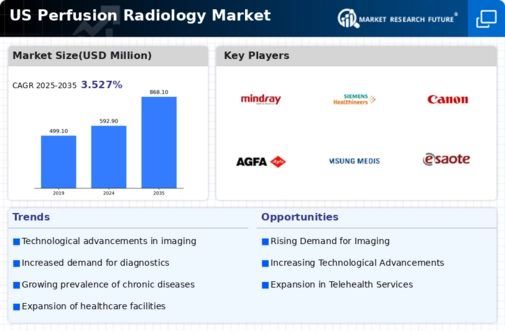Advancements in Imaging Technologies
Technological innovations in imaging modalities are propelling the growth of the perfusion radiology market. The introduction of high-resolution imaging techniques, such as MRI and CT perfusion, has enhanced the ability to visualize blood flow dynamics in real-time. These advancements allow for more accurate diagnoses and treatment planning, particularly in oncology and neurology. The market for advanced imaging technologies is expected to reach approximately $5 billion by 2027, reflecting a robust demand for sophisticated imaging solutions. As healthcare facilities invest in state-of-the-art equipment, the perfusion radiology market is poised for growth, driven by the need for precise and efficient diagnostic tools that can improve patient care and outcomes.
Increased Focus on Personalized Medicine
The shift towards personalized medicine is influencing the perfusion radiology market significantly. Tailoring treatment plans based on individual patient profiles necessitates advanced imaging techniques to assess perfusion characteristics accurately. This trend is particularly evident in oncology, where perfusion imaging can help determine tumor response to therapy. The market is anticipated to grow as healthcare providers increasingly adopt personalized approaches, with projections indicating a potential increase in market size by 15% over the next five years. The perfusion radiology market is likely to benefit from this paradigm shift, as it aligns with the broader movement towards individualized patient care and targeted therapies.
Rising Incidence of Cardiovascular Diseases
The increasing prevalence of cardiovascular diseases in the US is a primary driver for the perfusion radiology market. According to the American Heart Association, cardiovascular diseases account for approximately 697,000 deaths annually, representing about 1 in every 5 deaths. This alarming statistic underscores the urgent need for advanced diagnostic tools, including perfusion imaging techniques, to assess blood flow and tissue viability. As healthcare providers seek to improve patient outcomes, the demand for perfusion radiology services is expected to rise. The market is projected to grow at a CAGR of around 8% over the next few years, driven by the need for early detection and intervention in cardiovascular conditions. Consequently, the perfusion radiology market is likely to experience significant expansion as healthcare systems adapt to these pressing health challenges.
Regulatory Support and Reimbursement Policies
Supportive regulatory frameworks and favorable reimbursement policies are crucial drivers for the perfusion radiology market. The Centers for Medicare & Medicaid Services (CMS) have recognized the importance of advanced imaging techniques in improving patient outcomes, leading to enhanced reimbursement rates for perfusion studies. This financial backing encourages healthcare providers to invest in advanced imaging technologies, thereby expanding the market. As reimbursement policies continue to evolve, the perfusion radiology market is likely to see increased adoption of these services, with an expected growth rate of 10% over the next few years. This trend highlights the critical role of policy in shaping the landscape of diagnostic imaging.
Growing Demand for Non-Invasive Diagnostic Procedures
The rising preference for non-invasive diagnostic procedures is a significant driver for the perfusion radiology market. Patients and healthcare providers alike are increasingly favoring techniques that minimize risk and discomfort. Non-invasive perfusion imaging methods, such as CT and MRI perfusion studies, offer valuable insights into vascular health without the need for invasive procedures. This trend is reflected in the growing adoption of these technologies across various healthcare settings. The market is projected to expand as more facilities integrate non-invasive imaging solutions into their diagnostic protocols, potentially increasing the market share of the perfusion radiology market by 20% in the coming years.





















Leave a Comment